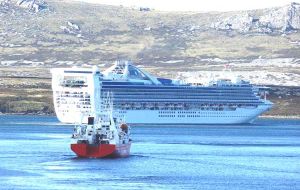MercoPress. South Atlantic News Agency
Lively discussion of Falklands' deep-water port options
 Cruise vessel and the Falklands' fisheries Patrol “parked” in Port Williams
Cruise vessel and the Falklands' fisheries Patrol “parked” in Port Williams Port William outside of Stanley Harbour is proving a popular option with the Falkland Islands business community for a future deep-water port, however environmentalists are less enthusiastic.
At a well-attended seminar held in Stanley Monday morning, three distinguished members of Falkland business each championed a site investigated in a recent Falkland Islands Development Corporation funded report by Royal Haskoning. The sites include the current floating dock in Stanley Harbour known as FIPASS; Port William West; Port William East (Ordnance Point) and Berkeley Sound, where the majority of fishing transhipping and bunkering currently takes place. Port William West proved most unpopular, possibly, among other factors, due to the inadequate water depth; a 400-metre causeway would be needed to reach 10metre depth or extensive dredging would be needed. Tom Blake of fishing company RBC Ltd., supporting the Port William options noted the Ordinance Point site (Latitude: 51° 40' 60 S, Longitude: 57° 49' 0 W) has easy navigation and explained it was only a short distance from shore to deep water, thus little or no dredging would be necessary. He noted there would also be a source of material from construction from the nearby Mary Hill Quarry. It is a short commute to the site and the Falkland Islands Government owns the surrounding land. A concern noted by one member of the public was the impact on the surrounding area. Gypsy Cove and Hadassa Bay in particular, are popular in leisure terms with both Islanders and visiting cruise vessel visitors. Speaking to Mercopresslater, Falklands Conservation Director Grant Munroe said, "I was not at the seminar today, however have been involved in the discussions previously and have received copies of the various reports. "Of the various options suggested the area between Hadassa Bay and Gypsy Cove is the most sensitive environmentally. "The site is within a National Nature Reserve. It was designated as a wildlife sanctuary in 1973 and subsequently upgraded to a National Nature Reserve in 1999. The protection within the NNR does not provide much if any protection above the general provisions of the 1999 Conservation of "Wildlife and Nature Ordinance 1999 that is applied to the entire Falklands. The designation prohibits the killing injuring or taking of any wildlife and the introduction of carnivorous animals with the exception of working sheep dogs. It does not prohibit development. The designation does however recognize the importance of the area as both a wildlife and recreational resource. "The coastline has been fenced for a number of years and is ungrazed. This has resulted in significant regeneration of tussac and native plants. The area contains approximately 200 breeding pairs of Magellanic Penguins. "Due to the sensitivity of the area and size of the development it would obviously be expected to undertake a full environmental impact of any development, which would consider direct and indirect impacts. This could consider ameliorating action which could improve other adjoining areas to offset loss of land to the development. "Falklands Conservation is not against development however should the site be chosen and no other alternatives were available the development should consider full environmental impacts, mitigation that could be conducted and where appropriate restoration of other areas to compensate and provide alternative breeding sites and reserves." At the seminar Mr Blake said there would be no direct impact on the wildlife at the two sites but acknowledged site development would mean a change to the environment. Berkeley Sound?Stuart Wallace of Fortuna Limited, championing Berkeley Sound explained it was important to, "â€Â¦think big and long term. Size is going to matter." In his opinion Islanders should consider the scale of possible change bearing in mind the industry is stable; changes in seafood market requirements; new uses of marine resources and the economics of reefer container services. More tellingly he asked, "What if Argentina has some success with their threats to our partnersâ€Â¦. We need the minimum of interaction with South Americaâ€Â¦ strategically the Falklands needs a deep water port with deep water berth – no complications." Mr Wallace also drew attention to the mass development over recent years in the port of Puerto Deseado in Patagonia – indicating that there was no reason not to be similarly ambitious. Lewis Clifton of the Byron Marine Group spoke of the advantages of the FIPASS site in that it was a "natural springboard" and could be developed with "bolt-ons". He said construction access was easy and could commence immediately. A vote, however, at the end of the seminar showed development of the FIPASS Stanley Harbour site was relatively unpopular. Many noted the nervousness of fishing vessel captains due to the lack of manoeuvrability within the harbour, made worse by strong winds. Impact on the cruise ship industry was also a strong topic as was impact on the environment. Chairing the seminar, Falkland Islands Development Corporation, Mark Brunet said the aim of the meeting was to assist the Falkland Islands Government in making a decision on the site. The Royal Haskoning Report of 2007 follows three others; the Mott MacDonald Report of 2001, a report by the Economic Adviser in 2002 and one by Jonathan Packer and Associates in 2003. By Lisa Johnston - SeAled PR - Stanley




Top Comments
Disclaimer & comment rulesCommenting for this story is now closed.
If you have a Facebook account, become a fan and comment on our Facebook Page!